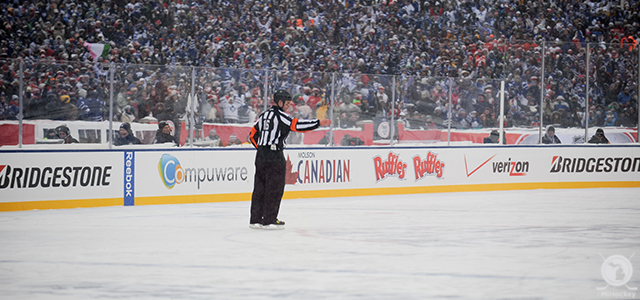Pletsch: Rule changes necessary for the NHL moving forward

By Fred Pletsch –
The NHL needs a safety net of common sense to ensure the integrity of the on-ice administration of the game.
As an exercise in predictability before their post-game comments, I pre-selected one word for each coach to use (‘breaks’ for Mike Babcock and ‘embarrassing’ for Darryl Sutter) following Detroit’s shootout win against Los Angeles on Jan. 18th at the Joe. A bizarre sequence near the end of regulation time resulted in Niklas Kronwall’s game-tying goal that rolled down Jonathan Quick’s back and into the net after a slapshot deflected off a stick and the puck sprung back into play from the protective netting at least 10 feet above the glass. None of the four on-ice officials saw what happened and even though executives working the league’s situation room in Toronto witnessed the egregious oversight, they couldn’t get involved because, under NHL rules, the play was not subject to video review.
Babcock – “We got a good break and got rewarded for it. The referees didn’t see it. But as you know, you get breaks against you lots, we’ve had some called back this year, and this was a break we got.”
Sutter – “That’s embarrassing for the league. It doesn’t matter if we had scored it or they had scored it. That’s embarrassing.”
It is time-honored, post-game chatter in these situations whereby the beneficiary (Detroit) always seems to be owed a well-deserved break while the aggrieved party (Los Angeles) knows redress is impossible under the rulebook, and also knows there’s immunity from calling the situation embarrassing because, well, that’s exactly what it is.
There is a reason that the NHL Official Rules book is 224 pages, the NCAA Rules and Interpretations book is 163 pages and USA Hockey’s Official Rules of Ice Hockey and Casebook is 404 pages. No single document can ever begin to anticipate all of the scenarios and situations that can possibly present themselves when a dozen men skating 30 mph are chasing and shooting a six-ounce piece of rubber at speeds of up to 100 mph. They are, by nature, ever-expanding documents whose content is driven by, among other considerations, player safety (hybrid icing), equipment (shallower nets and smaller goalie gear), entertainment (shootouts and elimination of the red line) and reactionary measures dictated by the type of events that transpired on Jan. 18.
An NHL game stops for video review to determine whether a player deserves a penalty for shooting the puck directly out of play, but a coach doesn’t get a single chance to question the sequence that leads directly to a goal? This doesn’t seem right if we all agree that the purpose of video review is to make the right call.
NCAA rules allow for video review “to determine if a goal was scored, as a direct result of the puck deflecting off of the protective netting above the glass.” They also allow a team to use its timeout to make referees review situations covered by video replay criteria.
Of course, video review can only rectify situations governed by the league’s criteria and a Kings coach’s challenge would’ve been rebuffed anyway. Some simple language referencing use of a coach’s challenge ‘to correct an obvious or undetected error’ would suffice to cover every conceivable, and inconceivable, situation (pucks off netting, too many players on the ice, extra puck thrown into play, etc., etc., etc.)
Who knows, maybe after a review that resulted in the correct no-goal call, the Red Wings score off of the ensuing faceoff anyway?
As the French philosopher Voltaire noted, “Common sense is not so common.” The coach’s challenge originally proposed by Florida general manager Dale Tallon makes more sense with each bewildering NHL moment.
Twitter – @PletscHockey


Pingback:Homepage